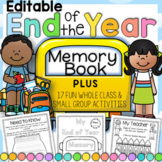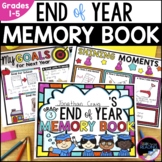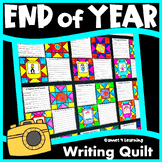27 results
Autumn teacher manuals $5-10
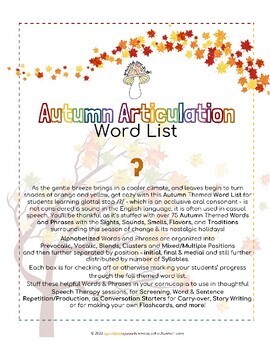
AUTUMN Articulation WORD LIST - ʔ - Speckled Speech Therapy Materials
Rationale: Although the glottal stop /ʔ/ - which is an occlusive oral consonant - is not considered a sound in the English language, it is often used in casual speech.This Autumn themed Word and Phrase Checklist contains about 79 target words with /ʔ/ in initial, final, medial position of words, as well as blends and clustersProcedure: Read each word aloud and listen to your student’s production. Depending on your student’s level and ability and at the discretion of the articulation specialist,
Subjects:
Grades:
Not Grade Specific
Also included in: HUGE AUTUMN Articulation Word List Collection for Speech Pathology
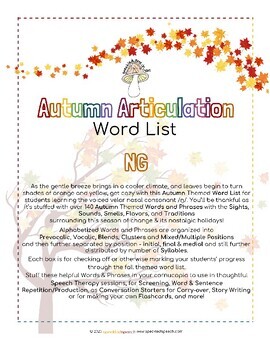
AUTUMN Articulation WORD LIST - NG - Speckled Speech Therapy Materials
Rationale: It is typical for children to use phonological processes for various sounds while learning to speak. According to Poole’s Norms* 90% of children develop the voiced velar nasal consonant /ŋ/ by the age of 7. Misarticulation of /ŋ/ by this age is categorized as a phonological disorder at which time it is considered ethical and advisable to begin assessment by a Speech and Language Pathologist leading to early intervention for optimal outcome. (*Poole, Sander, Hena, Fudala, Templin &am
Subjects:
Grades:
Not Grade Specific
Also included in: HUGE AUTUMN Articulation Word List Collection for Speech Pathology
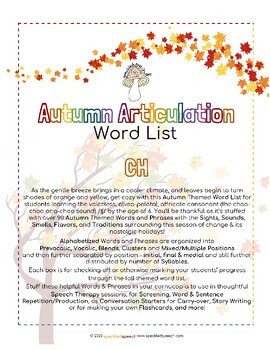
AUTUMN Articulation WORD LIST - CH - Speckled Speech Therapy Materials
Rationale: It is typical for children to use phonological processes for various sounds while learning to speak. According to Poole’s Norms* 90% of children develop the voiceless, alveo-palatal, affricate consonant (the choo-choo or a-choo sound) by the age of 6. Misarticulation of /ʧ/ by this age is categorized as a phonological disorder at which time it is considered ethical and advisable to begin assessment by a Speech and Language Pathologist leading to early intervention for optimal outcom
Subjects:
Grades:
Not Grade Specific
Also included in: HUGE AUTUMN Articulation Word List Collection for Speech Pathology

AUTUMN Articulation WORD LIST - Z - Speckled Speech Therapy Materials
Rationale: It is typical for children to use phonological processes for various sounds while learning to speak. According to Poole’s Norms* 90% of children develop the voiced, alveolar fricative /z/ should be mastered by the age of 7. Misarticulation of /z/ by this age is categorized as a phonological disorder at which time it is considered ethical and advisable to begin assessment by a Speech and Language Pathologist leading to early intervention for optimal outcome. (*Poole, Sander, Hena, Fu
Subjects:
Grades:
Not Grade Specific
Also included in: HUGE AUTUMN Articulation Word List Collection for Speech Pathology

AUTUMN Articulation WORD LIST - Y - Speckled Speech Therapy Materials
Rationale: It is typical for children to use phonological processes for various sounds while learning to speak. According to Poole’s Norms* 90% of children develop the voiced, palatal, glide consonant /y/ should be mastered by the age of 4. Misarticulation of /y/ by this age is categorized as a phonological disorder at which time it is considered ethical and advisable to begin assessment by a Speech and Language Pathologist leading to early intervention for optimal outcome. (*Poole, Sander, He
Subjects:
Grades:
Not Grade Specific
Also included in: HUGE AUTUMN Articulation Word List Collection for Speech Pathology
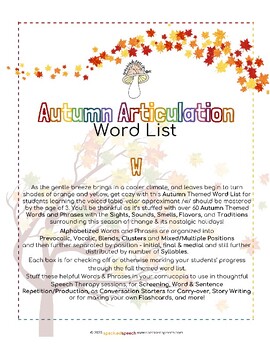
AUTUMN Articulation WORD LIST - W - Speckled Speech Therapy Materials
Rationale: It is typical for children to use phonological processes for various sounds while learning to speak. According to Poole’s Norms* 90% of children develop the voiced labio-velar approximant /w/ should be mastered by the age of 3. Misarticulation of /w/ by this age is categorized as a phonological disorder at which time it is considered ethical and advisable to begin assessment by a Speech and Language Pathologist leading to early intervention for optimal outcome. (*Poole, Sander, Hena
Subjects:
Grades:
Not Grade Specific
Also included in: HUGE AUTUMN Articulation Word List Collection for Speech Pathology
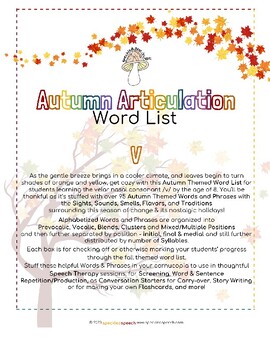
AUTUMN Articulation WORD LIST - V - Speckled Speech Therapy Materials
Rationale: It is typical for children to use phonological processes for various sounds while learning to speak. According to Poole’s Norms* 90% of children develop the velar nasal consonant /v/ by the age of 8. Misarticulation of /v/ by this age is categorized as a phonological disorder at which time it is considered ethical and advisable to begin assessment by a Speech and Language Pathologist leading to early intervention for optimal outcome. (*Poole, Sander, Hena, Fudala, Templin & Well
Subjects:
Grades:
Not Grade Specific
Also included in: HUGE AUTUMN Articulation Word List Collection for Speech Pathology

AUTUMN Articulation WORD LIST - TH - Speckled Speech Therapy Materials
Rationale: It is typical for children to use phonological processes for various sounds while learning to speak. According to Poole’s Norms* 90% of children develop the velar nasal consonant /θ,ð/ by the age of 8. Misarticulation of /θ,ð/ by this age is categorized as a phonological disorder at which time it is considered ethical and advisable to begin assessment by a Speech and Language Pathologist leading to early intervention for optimal outcome. (*Poole, Sander, Hena, Fudala, Templin &
Subjects:
Grades:
Not Grade Specific
Also included in: HUGE AUTUMN Articulation Word List Collection for Speech Pathology
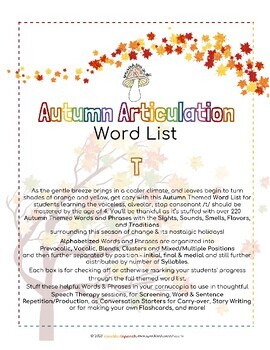
AUTUMN Articulation WORD LIST - T - Speckled Speech Therapy Materials
Rationale: It is typical for children to use phonological processes for various sounds while learning to speak. According to Poole’s Norms* 90% of children develop the voiceless, alveolar, stop consonant /t/ should be mastered by the age of 4. Misarticulation of /t/ by this age is categorized as a phonological disorder at which time it is considered ethical and advisable to begin assessment by a Speech and Language Pathologist leading to early intervention for optimal outcome. (*Poole, Sander,
Subjects:
Grades:
Not Grade Specific
Also included in: HUGE AUTUMN Articulation Word List Collection for Speech Pathology

AUTUMN Articulation WORD LIST - SH - Speckled Speech Therapy Materials
Rationale: It is typical for children to use phonological processes for various sounds while learning to speak. According to Poole’s Norms* 90% of children develop the unvoiced fricative consonant /ʃ/ (the be quiet sound) by the age of 6. Misarticulation of /ʃ/ by this age is categorized as a phonological disorder at which time it is considered ethical and advisable to begin assessment by a Speech and Language Pathologist leading to early intervention for optimal outcome. (*Poole, Sander, Hena
Subjects:
Grades:
Not Grade Specific
Also included in: HUGE AUTUMN Articulation Word List Collection for Speech Pathology

AUTUMN Articulation WORD LIST - S - Speckled Speech Therapy Materials
Rationale: It is typical for children to use phonological processes for various sounds while learning to speak. According to Poole’s Norms* 90% of children develop the voiceless alveolar fricative consonant /s/ (the snake sound) by the age of 7. Misarticulation of /s/ by this age is categorized as a phonological disorder at which time it is considered ethical and advisable to begin assessment by a Speech and Language Pathologist leading to early intervention for optimal outcome. (*Poole, Sande
Subjects:
Grades:
Not Grade Specific
Also included in: HUGE AUTUMN Articulation Word List Collection for Speech Pathology
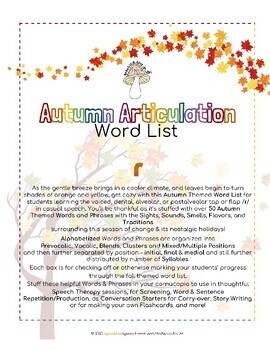
AUTUMN Articulation WORD LIST - ɾ - Speckled Speech Therapy Materials
Rationale: It is typical for use the voiced, dental, alveolar, or postalveolar tap or flap /ɾ/ when speaking casually. This Autumn themed Word and Phrase Checklist contains about 50 target words with the /ɾ/ in initial, final, medial position of words, as well as blends and clusters, is recommended for, but not limited to, students who have mastered unprompted production of the sound in, for example, word repetition, word reading, sentence repetition, sentence formulation levels by 80% or more.P
Subjects:
Grades:
Not Grade Specific
Also included in: HUGE AUTUMN Articulation Word List Collection for Speech Pathology
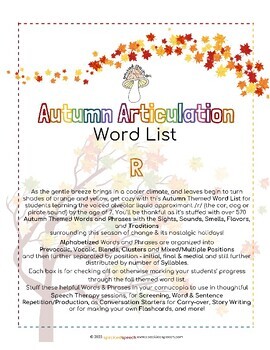
AUTUMN Articulation WORD LIST - R - Speckled Speech Therapy Materials
Rationale: It is typical for children to use phonological processes for various sounds while learning to speak. According to Poole’s Norms* 90% of children develop the voiced alveolar liquid approximant /r/ (the car, dog or pirate sound) by the age of 7. Misarticulation of /r/ by this age is categorized as a phonological disorder at which time it is considered ethical and advisable to begin assessment by a Speech and Language Pathologist leading to early intervention for optimal outcome. (*Poo
Subjects:
Grades:
Not Grade Specific
Also included in: HUGE AUTUMN Articulation Word List Collection for Speech Pathology
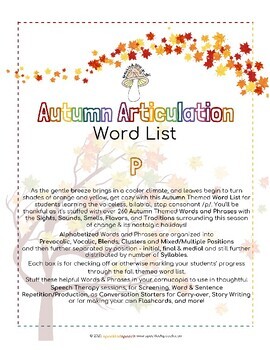
AUTUMN Articulation WORD LIST - P - Speckled Speech Therapy Materials
Rationale: It is typical for children to use phonological processes for various sounds while learning to speak. According to Poole’s Norms* 90% of children develop the voiceless, bilabial, stop consonant /p/ should be mastered by the age of 3. Misarticulation of /p/ by this age is categorized as a phonological disorder at which time it is considered ethical and advisable to begin assessment by a Speech and Language Pathologist leading to early intervention for optimal outcome. (*Poole, Sander,
Subjects:
Grades:
Not Grade Specific
Also included in: HUGE AUTUMN Articulation Word List Collection for Speech Pathology
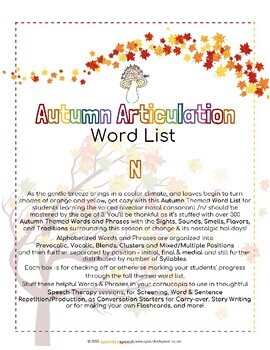
AUTUMN Articulation WORD LIST - N - Speckled Speech Therapy Materials
Rationale: It is typical for children to use phonological processes for various sounds while learning to speak. According to Poole’s Norms* 90% of children develop the voiced alveolar nasal consonant /n/ should be mastered by the age of 3. Misarticulation of /n/ by this age is categorized as a phonological disorder at which time it is considered ethical and advisable to begin assessment by a Speech and Language Pathologist leading to early intervention for optimal outcome. (*Poole, Sander, Hen
Subjects:
Grades:
Not Grade Specific
Also included in: HUGE AUTUMN Articulation Word List Collection for Speech Pathology
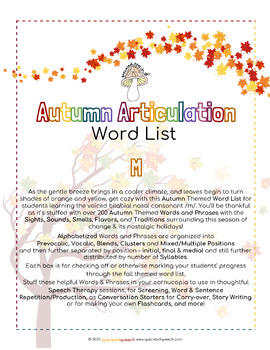
AUTUMN Articulation WORD LIST - M - Speckled Speech Therapy Materials
Rationale: It is typical for children to use phonological processes for various sounds while learning to speak. According to Poole’s Norms* 90% of children develop the voiced bilabial nasal consonant /m/ should be mastered by the age of 3. Misarticulation of /m/ by this age is categorized as a phonological disorder at which time it is considered ethical and advisable to begin assessment by a Speech and Language Pathologist leading to early intervention for optimal outcome. (*Poole, Sander, Hen
Subjects:
Grades:
Not Grade Specific
Also included in: HUGE AUTUMN Articulation Word List Collection for Speech Pathology
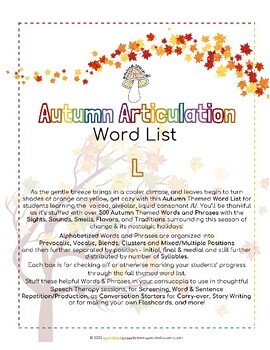
AUTUMN Articulation WORD LIST - L - Speckled Speech Therapy Materials
Rationale: It is typical for children to use phonological processes for various sounds while learning to speak. According to Poole’s Norms* 90% of children develop the voiced, alveolar, liquid consonant /l/ by the age of 6. Misarticulation of /l/ by this age is categorized as a phonological disorder at which time it is considered ethical and advisable to begin assessment by a Speech and Language Pathologist leading to early intervention for optimal outcome. (*Poole, Sander, Hena, Fudala, Templ
Subjects:
Grades:
Not Grade Specific
Also included in: HUGE AUTUMN Articulation Word List Collection for Speech Pathology
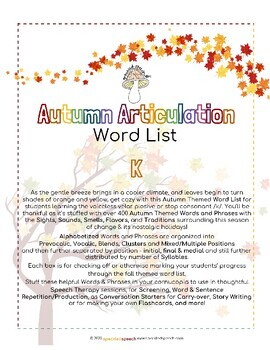
AUTUMN Articulation WORD LIST - K - Speckled Speech Therapy Materials
Rationale: It is typical for children to use phonological processes for various sounds while learning to speak. According to Poole’s Norms* 90% of children develop the voiceless velar plosive or stop consonant /k/ by the age of 4. Misarticulation of /k/ by this age is categorized as a phonological disorder at which time it is considered ethical and advisable to begin assessment by a Speech and Language Pathologist leading to early intervention for optimal outcome. (*Poole, Sander, Hena, Fudala
Subjects:
Grades:
Not Grade Specific
Also included in: HUGE AUTUMN Articulation Word List Collection for Speech Pathology
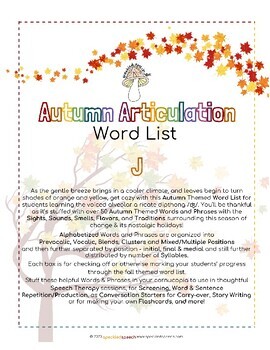
AUTUMN Articulation WORD LIST - J - Speckled Speech Therapy Materials
Rationale: It is typical for children to use phonological processes for various sounds while learning to speak. According to Poole’s Norms* 90% of children develop the voiced alveolar affricate diphthong /ʤ/ by the age of 6. Misarticulation of /ʤ/ by this age is categorized as a phonological disorder at which time it is considered ethical and advisable to begin assessment by a Speech and Language Pathologist leading to early intervention for optimal outcome. (*Poole, Sander, Hena, Fudala, Temp
Subjects:
Grades:
Not Grade Specific
Also included in: HUGE AUTUMN Articulation Word List Collection for Speech Pathology
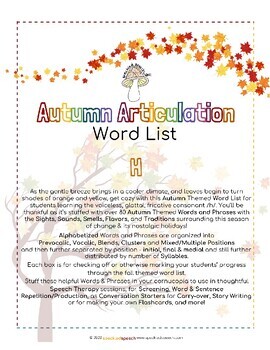
AUTUMN Articulation WORD LIST - H - Speckled Speech Therapy Materials
Rationale: It is typical for children to use phonological processes for various sounds while learning to speak. According to Poole’s Norms* 90% of children develop the voiceless, glottal, fricative consonant /h/ and should be mastered by the age of 3. Misarticulation of /h/ by this age is categorized as a phonological disorder at which time it is considered ethical and advisable to begin assessment by a Speech and Language Pathologist leading to early intervention for optimal outcome. (*Poole,
Subjects:
Grades:
Not Grade Specific
Also included in: HUGE AUTUMN Articulation Word List Collection for Speech Pathology

AUTUMN Articulation WORD LIST - G - Speckled Speech Therapy Materials
Rationale: It is typical for children to use phonological processes for various sounds while learning to speak. According to Poole’s Norms* 90% of children develop the voiced velar stop consonant /g/ by the age of 4. Misarticulation of /g/ by this age is categorized as a phonological disorder at which time it is considered ethical and advisable to begin assessment by a Speech and Language Pathologist leading to early intervention for optimal outcome. (*Poole, Sander, Hena, Fudala, Templin &
Subjects:
Grades:
Not Grade Specific
Also included in: HUGE AUTUMN Articulation Word List Collection for Speech Pathology
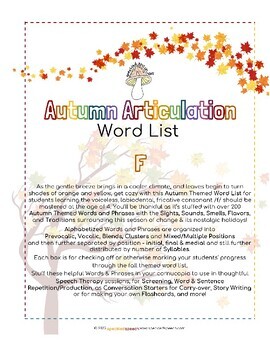
AUTUMN Articulation WORD LIST - F - Speckled Speech Therapy Materials
Rationale: It is typical for children to use phonological processes for various sounds while learning to speak. According to Poole’s Norms* 90% of children develop the voiceless, labiodental, fricative consonant /f/ should be mastered at the age of 4. Misarticulation of /f/ by this age is categorized as a phonological disorder at which time it is considered ethical and advisable to begin assessment by a Speech and Language Pathologist leading to early intervention for optimal outcome. (*Poole,
Subjects:
Grades:
Not Grade Specific
Also included in: HUGE AUTUMN Articulation Word List Collection for Speech Pathology

AUTUMN Articulation WORD LIST - D - Speckled Speech Therapy Materials
Rationale & Proposed ProtocolRationale: It is typical for children to use phonological processes for various sounds while learning to speak. According to Poole’s Norms* 90% of children develop the voiced, alveolar, stop consonant /d/ should be mastered by the age of 4. Misarticulation of /d/ by this age is categorized as a phonological disorder at which time it is considered ethical and advisable to begin assessment by a Speech and Language Pathologist leading to early intervention for opt
Subjects:
Grades:
Not Grade Specific
Also included in: HUGE AUTUMN Articulation Word List Collection for Speech Pathology
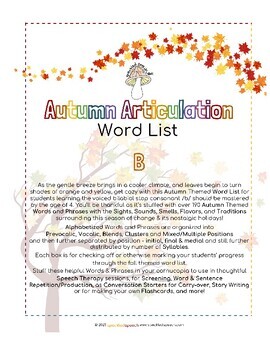
AUTUMN Articulation WORD LIST - B - Speckled Speech Therapy Materials
Rationale: It is typical for children to use phonological processes for various sounds while learning to speak. According to Poole’s Norms* 90% of children develop the voiced bilabial stop consonant /b/ should be mastered by the age of 4. Misarticulation of /b/ by this age is categorized as a phonological disorder at which time it is considered ethical and advisable to begin assessment by a Speech and Language Pathologist leading to early intervention for optimal outcome. (*Poole, Sander, Hena
Subjects:
Grades:
Not Grade Specific
Also included in: HUGE AUTUMN Articulation Word List Collection for Speech Pathology
Showing 1-24 of 27 results

